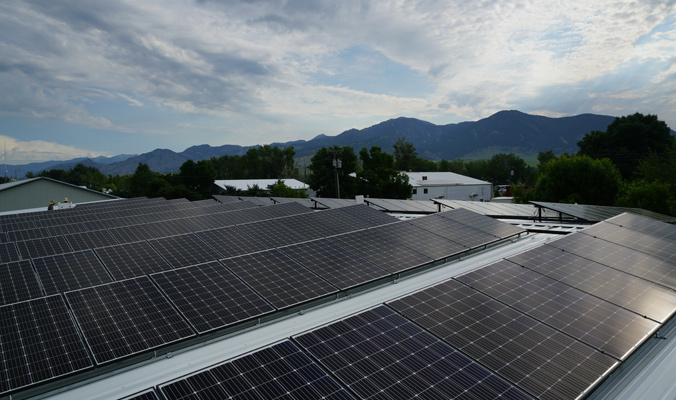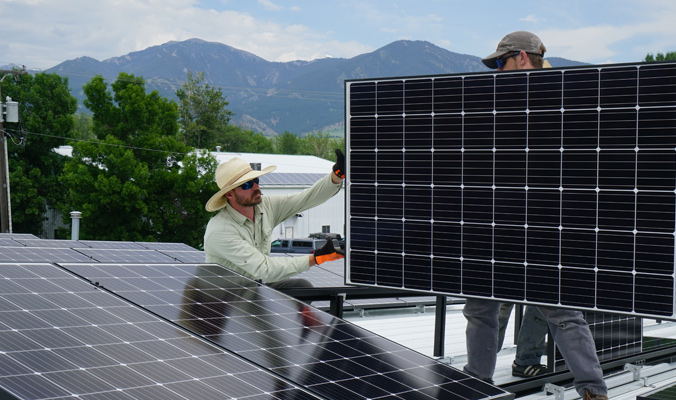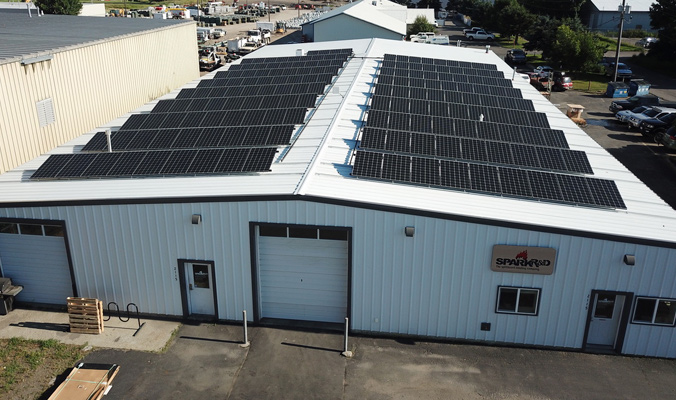
Spark R&D’s solar array soaks in views of Montana’s Bridger Range. [Photo] Courtesy Spark R&D
The company—which caters to those pursuing human-powered recreation—is now able to cover around 25 percent of their power using 166 solar panels installed on their facility’s roof. For a business that’s growing by at least 10 percent every year and that produces everything down to the tiniest screw, this project highlights Spark R&D’s focus on smart and sustainable growth.
For owners Will and Becca Ritter, the idea of installing solar panels has been a long time coming—ever since they bought their 12,000-square-foot building in 2016.
“It was one of the first things we did; we bought the building in March and had the solar company come over in June,” Becca says. When explaining the vision behind the project, she emphasizes, “We’re not just making splitboard bindings here, we’re putting our money where our mouth is. It’s what we believe in, and we show what we believe in with our products. Yes, there’s a financial incentive, and, yes, it’s good for business, but it’s also just the right thing to do.”

The Spark R&D team installs the solar panels on the roof of their manufacturing facility with the help of the OnSite Energy company. [Photo] Courtesy Spark R&D
During the lengthy two-year grant application process, Spark R&D continued to add more machines and ramp up their energy consumption. “It’s a federal program with a lot of paperwork, and a lot of noise comes along with it, but we are thankful to do it all,” says Becca. And the process is well worth it; Spark R&D now has one quarter of all associated costs covered.
After receiving the REAP grant in May 2017, Spark R&D still had ground to cover, including working with an electrician to consolidate existing electrical panels before the solar panels could be permanently installed. When reviewing the entire process, Becca explains, “We still had to be approved by the city and have an engineer come and make sure that our building is capable of all this weight.”
In one workweek, OnSite Energy Inc. laid the infrastructure and solar panels on Spark R&D’s rooftop within view of the Bridger Range. While this project is a big step for the small company, the Ritters have their sights set on a brighter future; 166 panels could be just the beginning for Spark R&D’s solar array.
Currently the Ritters are working to install panels that will allow them to produce 50 kilowatts of energy, but for now, that is the most energy they will be able to produce. Becca spells out the issue that “there’s a law in Montana where your solar cannot exceed 50 kilowatts of generated power if you’re tied to the grid, which we are.” Their fingers are crossed that this law will eventually change so that they can expand solar panels across the remainder of their rooftop.

Spark is looking to expand their array if Montana’s 50 KW limitation is changed. [Photo] Courtesy Spark R&D
And Ventura hopes other companies will take note of Spark’s renewable energy commitment. “You can build outdoor equipment sustainably if you place an emphasis on it. For us, we are what we emphasize, and we are a backcountry-specific snowboarding company that tries to stay true to its roots and true to its vision of building a great product.” Becca says. “This is what Spark is—we make all of our stuff, why not make our own power too?”











Related posts: